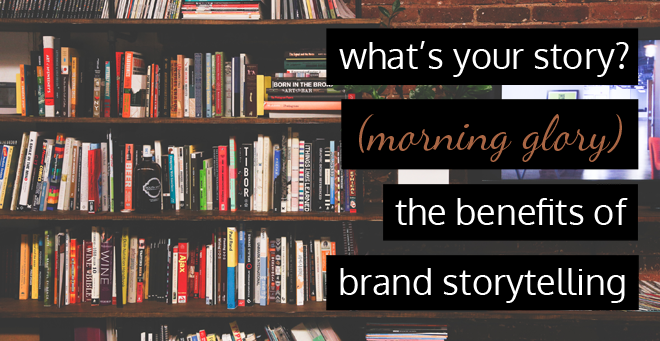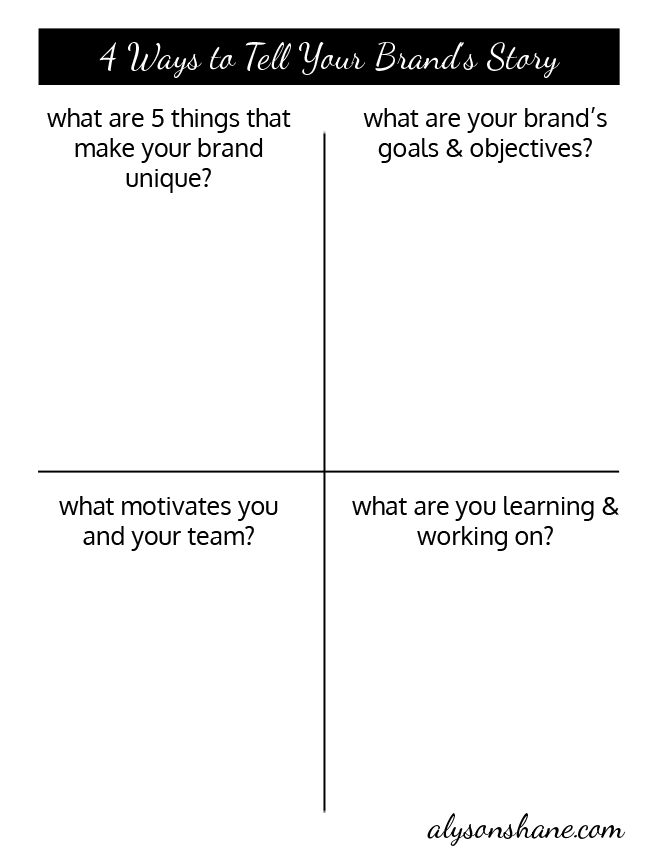Tagged: Content
Marketing Your Brand Through Storytelling
- by Alyson Shane

Stories are way more memorable than regular 'ol marketing content, and are a great way to tell your audience about your brand, build trust, and help them see you as more than just a company or an organization.
There are a couple of ways that your brand story is built: either through content created by you (blog posts, social profiles, etc) or by stories and experiences that your audience share online.
The culmination of both of these tells your brand story, and by being pro-active and sharing content about you, your team, and your brand, you can help shape the way that your audience interact with you, and influence how they help you tell your brand story.

Tell your origin story
Like any good superhero, your brand needs an origin story. Nostalgia is the best way to connect history to your brand, product, logo, etc and it helps re-affirm your brand's vision and goals to your audience.
It doesn't have to be wild and crazy (unless you actually were bitten by a radioactive spider) but it does have to meet the following criteria:
- Be true (don't lie, guys. The internet will find out and you'll lose all your cred)
- Be interesting (really this is just in how you tell it; rhetoric is key)
- Be honest (tell your audience what motivated you, what your struggles were, etc)
This is important because people want to know the history behind a brand or product before they begin to attach themselves to it emotionally. The more compelling your reasons for founding your cool startup or starting to knit all those awesome cat sweaters, the more people will give you emotional buy-in (that is, start to genuinely care about you) and the more attention you'll get.
Talk about your goals & challenges
Once you've started to share where you came from, talk about where you're going and chronicle the steps you're taking to get there. Share blog posts, photos and video of the project as it develops. Blog regularly about your progress, the things you've learned, technical problems you've been struggling to solve (and how you solved them) - anything that shows your audience that there's a real person (or team of people) behind the scenes.
If you're a multi-person organization, having various team members from different parts of your company share content is a great way to connect with a variety of audience members. For instance, have a programmer blog about challenges they had building a section of your product, or have your graphic designer share an Instagram photo of a few concept pieces (bonus points if they can briefly discuss why they were or weren't rejected.) By sharing a variety of stories describing your goals and challenges, your brand appears more dynamic, interesting, and relatable.
Talk about your audience
One of the best ways to connect with your audience is to tell a story about one of your consumers, or a member of your community. This is a neat trick to include people in your brand's larger story, and encourages others to contact you with their own experiences in the hopes that they can be included, too.
A great example of this is Apple's iPhone commercials, which show regular people taking photos and video using their iPhone camera. This is a great example of brand storytelling, and it doesn't even use words! The reason this is a powerful technique is because showcasing other people's experiences helps put your audience in a similar mindset. They start thinking "what is my experience like? Do I relate to what I've seen? Why or why not?" (maybe not quite that linear, but you get my drift.)
But what do you do if you don't have a product on the market to replicate an Apple-esque story? Instead, find testimonials from people who have tried your software, worked with you in some capacity, or done some beta-testing and would be comfortable sharing their experiences. Don't limit yourself to consumers; anyone can be a part of your brand's story if you invite them in.
Still stuck?
Here's a handy print-out for you to fill out and use (or just to get you thinking!) about the kinds of stories you can tell about your brand.

Do you have any favourite brand stories? Have you ever been featured in one? I'd love to know!
The Guide to Creating Killer Content
- by Alyson Shane

Once upon a time, back in the old days of 1996 Bill Gates wrote an article called Content is King. In it, he talks about the future of the internet, and how this new and exciting medium can be used to distribute information worldwide at basically zero cost. He also discussed how content isn't one single idea or thought, but rather the sum-total of everything that we share online, which can include ideas, products, and experiences.
Bill Gates is clearly a clever guy (duh) and his article is still as relevant today as it was when I first read it in Computer Science class. Nowadays, however, we have a multitude of ways and means to create and share content under the guise of your brand, professional or personal.
This can be anything including:
- Your website
- Blog posts
- Original images, photos and infographics
- Your profile photos across social networks
- Social media profiles including:
- Tweets on Twitter
- Facebook status updates
- Instagram photos
- Youtube or Vimeo videos
- Pinterest pins
- Google+ content
- LinkedIn updates
- Newsletter emails
- Emails you send to clients and colleagues
- Handouts, checklists, ebooks and resources you've created
- Other stuff of this nature (you get the drift)
The sum total of all of this stuff is how people will perceive you online, so your content really matters. People will click around to your Twitter, LinkedIn, Pinterest, website, and anywhere else you hang out online to try and suss out who you are and what they think of you.
The kind of content you share determines your value to other people, so today we're going to go through a few quick & dirty questions that you can ask yourself to make sure that you're creating and sharing the best possible content that helps people see who you really are, and adds value to your brand.
Does your content help others?
One of the biggest takeaways for me from the #SocialHour Twitter chat last week was that everyone indicated that they considered quality content to be helpful and informative. People are looking for posts, articles, and images that give them information and help them solve problems that can't be easily Googled.
This means that some of the best content you can create is the kind that answers questions, presents solutions to problems, and is otherwise generally helpful.
Here are some questions you can ask to determine some helpful content you can create:
- What kind of content do you like to read?
- What kind of content does your audience like?
- Hint: check stuff like your Twitter analytics to see what sorts of shared content resonate with your audience
- What sort of content are other businesses in your field sharing?
- What kinds of questions are being asked in blog comments, Twitter chats, etc that you can answer for my audience?
- What sorts of topics interest you, and would be fun to explore and learn in order to share?
- Can you turn any of these content ideas into long-term projects, video tutorials, printables, white papers, and other resources your audience can use?

Are you authentic?
Aka, does the way that you're presenting content online jive with who you are in real-life?
We all try to put forward the best versions of ourselves online - that's normal, don't worry about that pressure (we all feel it) - but when it comes to our content we can share heaps of information, articles, and posts without actually saying anything about who we are if we're afraid to do so.
However, the more 'real' we can be online, the more people will gravitate to us and hear what we want to say. This is because people (read: your audience and potential future clients) aren't just coming to you because you have encyclopedic knowledge of Google Analytics, or you knit the best cat sweaters. They're coming to you because the like who you are, and part of helping people get to know the real you is by sharing parts of your life with them.
Here are a few ways you can help people get to know you:
- Share funny or interesting photos of your life
- Include relevant stories in blog posts and status updates
- If you're feeling brave, share a recent struggle and what you've learned from it
- Share what you know (check out The Case for Knowledge Sharing for more on that topic)
Additionally - and I've said this before - make an honest and concerted effort to be positive online. Part of being authentic is sharing your struggles, challenges, and learning experiences, but don't actively badmouth, vaguebook, subtweet, or write passive-aggressive posts or emails about other businesses or people. We all have catty moments (we're human, after all) but you never know when it will come back to bite you.
Is your content entertaining?
#RealTalk time: you could be providing the best, most helpful content on the planet but if your posts read like cardboard and you sound like a Speak 'n Spell on video, nobody's going to want to take the time to hear what you have to say.
Here's an example: When I was in high school I had an amazing teacher named Mr. Kenny. He was so freakin' weird, you guys. He only cut his hair once a year for his wedding anniversary, wore a red nylon strap as a belt (the kind backpacks come with), and had less than a dozen tshirts, all of which he got for free and one of which said Is that your final antler? on it. He had the weirdest stories (like punching a kangaroo) and was always incredibly entertaining.
Mr. Kenny taught science (which I was embarrassingly bad at) and his students generally did really well because he was into what he was always super excited about what he was teaching, and he was such a character that he didn't have to work very hard to keep our attention.
Nowadays when I'm writing, or sharing things online, I try to channel Mr. Kenny's weirdness because I know that keeping people entertained is what keeps them coming back. It's not just about sharing information, it's about doing so in a way that keeps people interested and entertained.
How can you be more like Mr. Kenny? Ask your self some of these questions:
- What sorts of personal stories can you use to make your content more relatable?
- Can you work sarcasm and jokes into what you're writing?
- Can you find relevant interesting or funny photos, gifs, and videos to complement up your content?
- Would your audience appreciate seeing your goofy side?
Your turn!
Here are a few questions to get your brain waters going:
- What kind of content can you create this week that will benefit your brand?
- What fun, personal thing happened to you today that I can share with your audience?
- What are five topics I can write about this month that will benefit my audience?
Stumped for ideas? Leave a comment and let's chat about it!
